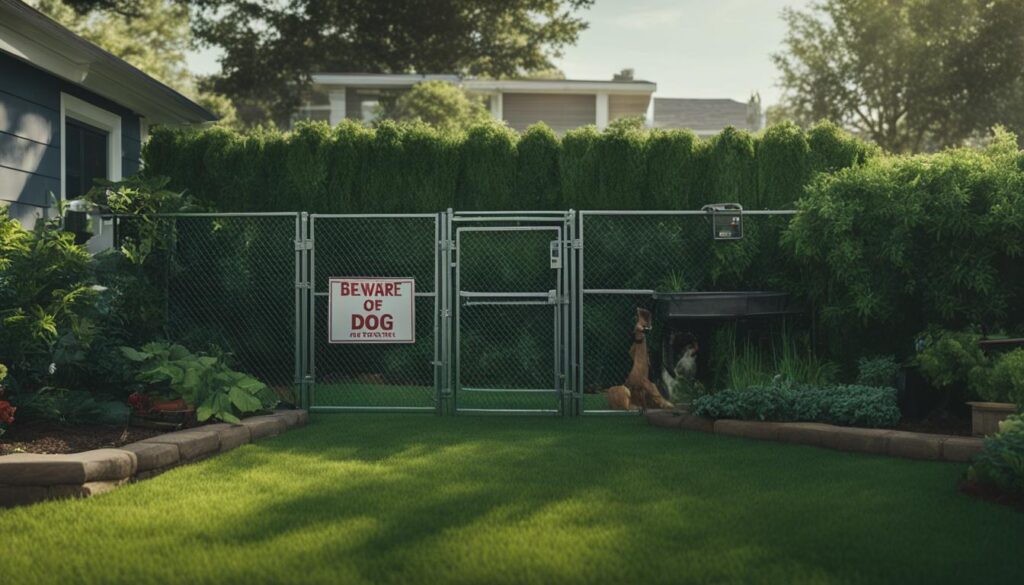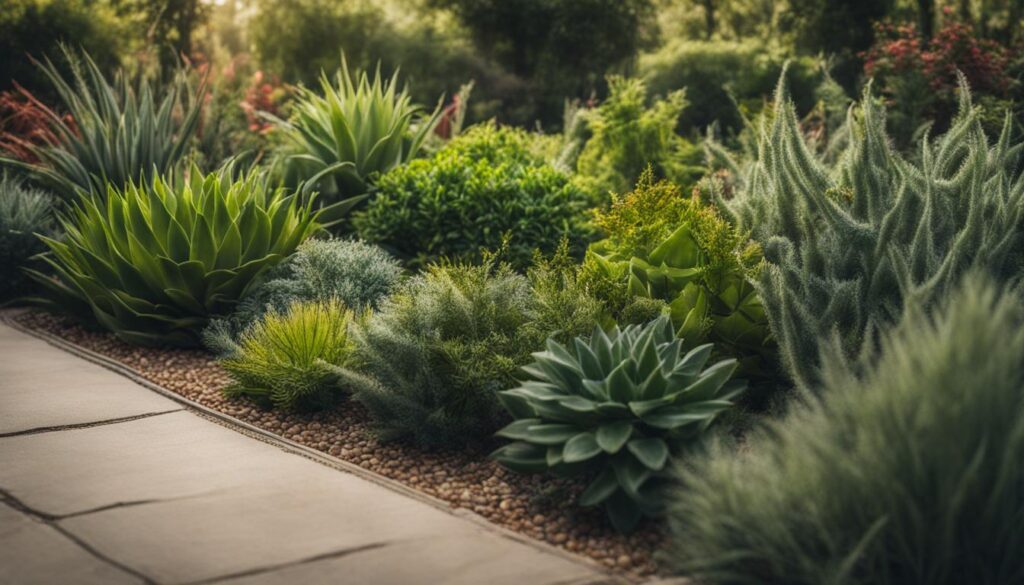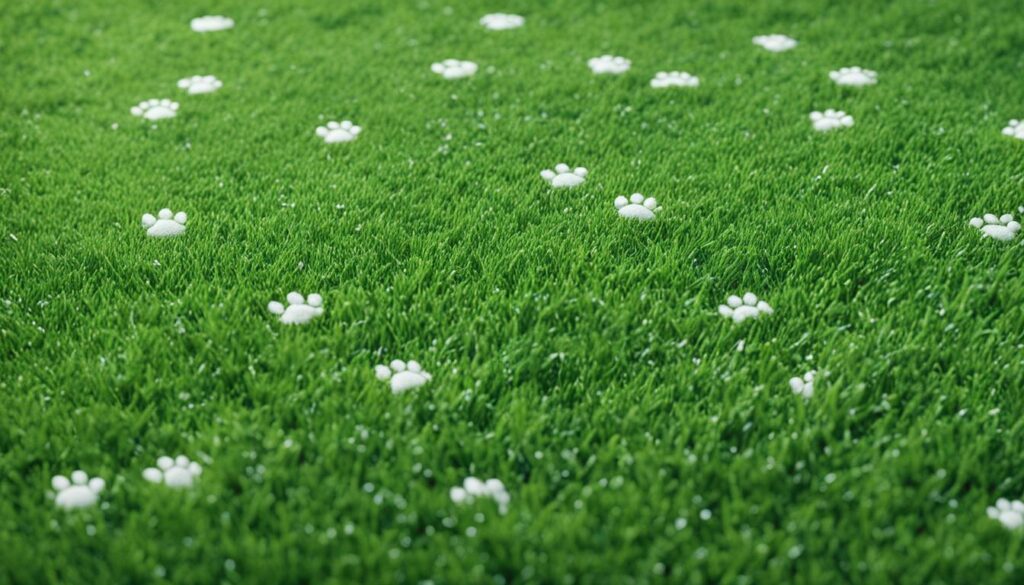Struggling with unwanted canine visitors? We have 16 expert-recommended strategies for keeping dogs out of your yard. If you have pets or if there are free-roaming animals in your neighborhood, it can add complications to maintaining your yard. Dogs can damage property by digging holes, chewing furniture, or knocking over garden art. They may also use your yard as a bathroom, which can kill your plants or lawn over time. Moreover, dogs you don’t know may carry diseases or be aggressive towards your family and pets. It is important to keep dogs out of your yard to preserve the integrity of your property and ensure the safety of everyone involved.
Key Takeaways:
- Implementing physical deterrents such as fences, hedges, and motion-activated sprinklers can help keep dogs out of your yard.
- Certain plants like marigolds and herbs with strong scents can act as natural dog repellents.
- Using natural scents like vinegar, citrus spray, or coyote urine can deter dogs from entering your yard.
- Spread baking soda or spray vinegar to neutralize the smell of dog urine and discourage dogs from returning.
- Consider changing your fertilizer to a plant-based option, planting lavender or shrubbery, and using commercial dog repellents for added protection.
Why should you keep dogs out of your yard?
There are several important reasons why you should keep dogs out of your yard. Firstly, dogs can cause damage to your property by digging holes, chewing furniture, or knocking over objects. They can also pose safety risks to themselves and others, especially if you have a swimming pool or toxic plants in your yard. Additionally, dogs using your yard as a bathroom can lead to dead patches of grass or plant damage. By keeping dogs out of your yard, you can prevent these issues and maintain a safe and aesthetically pleasing outdoor space.
Physical deterrents

One of the most common and reliable physical barriers for dogs is installing fences or hedges around your yard. Fences provide a clear boundary that dogs cannot easily breach, while hedges offer both visual privacy and a physical deterrent. By choosing the right fence or hedge material, height, and design, you can effectively dog-proof your yard.
By utilizing these physical deterrents, you can create an environment that discourages dogs from entering your yard. Whether it’s through the visual cues provided by bamboo stakes and fences or the physical limitations imposed by chicken wire and sedum, these barriers will help you maintain a dog-free space.
| Physical Deterrents | Description |
|---|---|
| Bamboo Stakes | Planting bamboo stakes to create a visual and physical barrier that dogs find challenging to navigate. |
| Chicken Wire | Laying chicken wire over the soil to prevent dogs from digging holes in your yard. |
| Cover Crops: Sedum | Planting sedum, a dense ground cover plant, to create a barrier against dogs. |
| Motion-Activated Sprinklers | Using motion-activated sprinklers to startle and deter dogs from entering your yard. |
| Fences or Hedges | Installing fences or hedges around your yard to create a clear boundary and physical deterrent. |
Plant deterrents

Certain plants can actually deter dogs from entering your yard. Marigolds or calendula emit a pungent odor that dogs find unpleasant. Herbs like rosemary, lavender, lemongrass, and lemon thyme also have strong scents that dogs dislike. Planting these herbs in your yard can help keep dogs away. Additionally, dense shrubs or spiky shrubbery planted along the perimeter of your yard can act as a natural barrier against dog invaders. By strategically utilizing plants, you can discourage dogs from entering your yard.
Plants that deter dogs:
- Marigolds or calendula
- Rosemary
- Lavender
- Lemongrass
- Lemon thyme
Using plants to keep dogs out:
By planting these dog-deterring plants in your yard, you can create an environment that dogs find unappealing. The pungent odor of marigolds and the strong scents of herbs like rosemary, lavender, lemongrass, and lemon thyme will discourage dogs from entering your yard. Additionally, dense shrubs or spiky shrubbery planted along the perimeter of your yard can serve as a visual and physical barrier, making it difficult for dogs to invade your space.
Natural Scent Deterrents

If you prefer to avoid using chemicals, there are natural scent deterrents that can help keep dogs out of your yard. These options utilize the power of natural scents to deter dogs from entering your property.
Vinegar-Soaked Rags
One effective natural dog repellent is vinegar-soaked rags. Simply soak rags in vinegar and tie them to stakes around your garden. The strong smell of vinegar will prevent dogs from nibbling on your plants, keeping them safe and intact.
Citrus Spray
Another option is to create a citrus spray using lemon juice and water. Spray this mixture around your yard, focusing on areas where dogs are prone to enter. The strong citrus scent is unpleasant to dogs and will discourage them from venturing into your yard.
Coyote Urine
While it may sound unappealing, coyote urine is a potent scent deterrent for dogs. Splash coyote urine around the perimeter of your yard to create an invisible barrier that dogs will avoid. This natural approach effectively keeps unwanted dogs out of your yard.
Coffee Grounds and Pepper
Another natural dog repellent option is to sprinkle coffee grounds and pepper around your yard. The strong aromas of coffee and pepper are unpleasant to dogs and will help deter them from entering your property.
By using these natural scent deterrents, you can create a dog-free environment in your yard without resorting to chemical-based repellents.
Spread baking soda and spray vinegar

When it comes to keeping dogs out of your yard, you can rely on the power of natural ingredients like baking soda and vinegar. These common household items can serve as effective dog repellents without harming the environment or endangering the animals themselves.
To make use of baking soda, simply spread it around the perimeter of your yard and in areas where dogs have urinated. Baking soda has the ability to neutralize the smell of dog urine, making it less enticing for dogs to return. By applying baking soda strategically, you can discourage dogs from entering your yard and mark it as an area they should avoid.
Another natural deterrent is vinegar. Undiluted vinegar can be sprayed around the perimeter of your yard and on spots where dogs have urinated. The strong scent of vinegar acts as an invisible fence, creating a barrier that dogs are reluctant to cross. Vinegar is safe for both dogs and humans, making it an ideal choice for keeping dogs away from your yard.
Change fertilizer and plant lavender or shrubbery

Dogs have a strong sense of smell, and they are often attracted to the organic materials found in fertilizer. To deter dogs from being drawn to your yard, consider changing your fertilizer to a plant-based option. Plant-based fertilizers typically have a milder scent that dogs find less appealing, reducing the likelihood of them entering your yard.
In addition to changing your fertilizer, incorporating lavender or shrubbery in your yard can act as a natural deterrent. Dogs find the scent of lavender unpleasant, which can help keep them away. Planting lavender strategically along the perimeter of your yard can create a barrier that dogs find difficult to navigate.
Furthermore, dense shrubbery can also serve as a physical barrier against dog invaders. Planting dense shrubs along the edges of your yard can make it challenging for dogs to access your property, reducing the chances of them entering.
By changing your fertilizer to a plant-based option and incorporating lavender or shrubbery, you can effectively repel dogs from your yard and create a dog-free environment.
| Fertilizer Options | Lavender Varieties | Shrubbery Types |
|---|---|---|
| Organic compost | English lavender | Boxwood shrubs |
| Manure-based fertilizers | French lavender | Privet shrubs |
| Seaweed-based fertilizers | Spike lavender | Arborvitae shrubs |
| Alfalfa meal | Lavandin lavender | Forsythia shrubs |
Use commercial dog repellents and install motion-activated sprinklers
If you’re looking for effective and high-tech methods to keep dogs out of your yard, consider using commercial dog repellents and motion-activated sprinklers. These innovative solutions can help you create a dog-free environment and maintain the integrity of your property.
Commercial dog repellents are available in sprays or powders and can be found at pet shops or garden supply stores. These products often contain natural ingredients that dogs find unpleasant, such as bitter apple or citrus. By applying these repellents around the perimeter of your yard, you can deter dogs from entering and safeguard your outdoor space.
In addition to repellents, motion-activated sprinklers are a high-tech solution for keeping dogs out of your yard. When a dog approaches, the motion sensor in these sprinklers detects the movement and triggers a burst of water, startling and deterring the dog from entering. Not only are motion-activated sprinklers effective, but they are also safe and harmless to both animals and humans.
By utilizing commercial dog repellents and motion-activated sprinklers, you can create a comprehensive dog deterrent system that effectively keeps dogs away from your yard. These advanced technologies provide a convenient and reliable way to maintain a dog-free environment and preserve the beauty of your outdoor space.
Extend your fence and remove climbing aids
If dogs are climbing or jumping over your fence, extending the fence can be an effective solution. Adding a section to the top of the fence that tilts inward or attaching a coyote roller to the fence can deter dogs from getting over.
It’s also important to remove any objects near the fence that dogs can climb on, such as wood piles or playground equipment. By extending the fence and removing climbing aids, you can make it more difficult for dogs to escape your yard.
Attach an L-footer and install an airlock or double gate
When dealing with dogs that have a knack for digging under the fence, attaching an L-footer along the bottom can serve as an effective deterrent. The L-footer can be made using chicken wire, hardware cloth, or a piece of chain-link fence. By burying the L-footer underground, you create an extra barrier that prevents dogs from burrowing out of your yard.
In addition to the L-footer, installing an airlock or double gate system can further reinforce the dog-proofing of your yard. An airlock is a small enclosed area that acts as a buffer between your yard and the outside world, making it more difficult for dogs to escape. Alternatively, a double gate system allows you to have two gates, one behind the other, creating an additional barrier that prevents dogs from slipping through the entrance.
By combining the use of an L-footer and an airlock or double gate, you can significantly increase the security of your fence and ensure a dog-proof yard.
Benefits of using an L-footer:
- Effectively deters dogs from digging under the fence
- Can be easily installed using common materials
- Creates an additional physical barrier to reinforce the fence
Advantages of installing an airlock or double gate:
- Creates a small enclosed area that makes it harder for dogs to escape
- Provides an extra layer of security to prevent unauthorized access
- Gives you peace of mind knowing that your yard is dog-proof
Block the View and Make the Yard a Happy Place
Dogs may attempt to escape if they see something outside the fence that they perceive as a threat or if they feel bored or lonely. To prevent this, you can block their view by adding slats to a chain-link fence or using rolls of bamboo or reed fencing.
Blocking the view not only deters escape but also provides dogs with a sense of security within the yard. Dogs are less likely to try and escape if they cannot see what’s happening beyond the fence.
In addition to blocking the view, it’s important to make your yard a happy place for your dog. Provide fresh water at all times, especially during hot weather, to ensure your dog stays hydrated. Create shaded areas with trees, umbrellas, or covered structures where your dog can relax and escape from the heat.
Interactive toys and puzzles can keep your dog mentally stimulated and entertained, reducing the likelihood of escape attempts out of boredom. Rotate toys regularly to prevent them from getting bored with the same toys.
Spending time with your dog in the yard is crucial for their wellbeing. Engage in interactive play, training sessions, or simply relax together. This not only strengthens the bond between you and your dog but also makes them feel content and less inclined to escape.
By blocking the view and creating a positive environment, you can decrease the desire for dogs to leave the yard and increase their overall happiness.
Dog-Friendly Yard Essentials
| Essential | Description |
|---|---|
| Fence with Slats or Natural Barriers | Create a physical deterrent that blocks the view and prevents escape. |
| Fresh Water | Provide a constant supply of clean water to keep your dog hydrated. |
| Shaded Areas | Create sheltered spots where your dog can cool down and relax. |
| Interactive Toys | Keep your dog mentally stimulated and entertained with engaging toys. |
| Bonding Time | Spend quality time with your dog in the yard to strengthen your relationship. |
Wrapping Up
Preventing dogs from entering your property and maintaining a dog-free yard is essential for preserving the integrity of your property and ensuring the safety of everyone involved. By utilizing a combination of effective strategies, you can create a dog-proof yard and enjoy a peaceful and secure outdoor space.
Implementing physical deterrents such as fences, hedges, and motion-activated sprinklers can create a barrier that dogs find difficult to navigate. Planting dog-repellent plants like marigolds, lavender, and dense shrubs can also help deter dogs from entering your yard. Additionally, natural scent deterrents like vinegar-soaked rags or citrus sprays can be effective in keeping dogs away.
For a more high-tech approach, consider using commercial dog repellents or installing motion-activated sprinklers. These innovative solutions can effectively deter dogs from entering your yard. Extending your fence, removing climbing aids, and utilizing an L-footer or airlock can reinforce your yard and make it more challenging for dogs to escape.
Lastly, by blocking the view and creating a happy and engaging environment in your yard, you can decrease the desire for dogs to leave your property. Remember to choose methods that are suitable for your specific situation and always prioritize the safety and well-being of both people and animals.
FAQ
How can I keep dogs out of my yard?
There are several effective strategies for keeping dogs out of your yard, including physical deterrents, plant deterrents, natural scent deterrents, spreading baking soda and spraying vinegar, changing fertilizer and planting lavender or shrubbery, using commercial dog repellents and motion-activated sprinklers, extending your fence and removing climbing aids, attaching an L-footer and installing an airlock or double gate, blocking the view and making the yard a happy place.
Why is it important to keep dogs out of my yard?
Keeping dogs out of your yard is important to prevent property damage, maintain a safe environment, and avoid conflicts with unknown dogs. Dogs can cause damage to your property, pose safety risks, and cause damage to plants and grass by using your yard as a bathroom. By keeping dogs out, you can preserve the integrity of your property and ensure the safety of everyone involved.
What are some physical deterrents for keeping dogs out of my yard?
Physical deterrents for keeping dogs out of your yard include using bamboo stakes, chicken wire, cover crops, motion-activated sprinklers, fences, and hedges. These deterrents can create barriers that dogs find difficult to navigate, preventing them from entering your yard.
What are some plant deterrents that can keep dogs away from my yard?
Some plants that can deter dogs from entering your yard include marigolds, calendula, rosemary, lavender, lemongrass, lemon thyme, and dense or spiky shrubs. These plants emit scents that dogs find unpleasant or create physical barriers that dogs find challenging to navigate.
What are some natural scent deterrents for keeping dogs out of my yard?
Natural scent deterrents for keeping dogs out of your yard include vinegar-soaked rags, citrus sprays, coyote urine, coffee grounds, and pepper. These scents can be unpleasant for dogs and help deter them from entering your yard.
How can I use baking soda and vinegar to keep dogs out of my yard?
Spreading baking soda around the perimeter of your yard and in areas where dogs have urinated can neutralize the smell of dog urine and discourage them from returning. Spraying undiluted vinegar around the perimeter and in areas where dogs have urinated can create an invisible fence and deter dogs from entering your yard.
How can changing fertilizer and planting lavender or shrubbery help keep dogs out of my yard?
Dogs are often attracted to the smell of organic materials in fertilizer. By changing your fertilizer to a plant-based option, you can help deter dogs from being drawn to your yard. Planting lavender or dense shrubbery along the perimeter of your yard can act as a natural deterrent since dogs find the scent of lavender unpleasant and dense shrubbery creates a physical barrier.
What are some commercial dog repellents and high-tech solutions for keeping dogs out of my yard?
Commercial dog repellents in sprays or powders and motion-activated sprinklers are effective options for keeping dogs out of your yard. These products can be found at pet shops or garden supply stores and can help deter dogs from entering your yard.
How can I extend my fence and remove climbing aids to keep dogs out of my yard?
Extending your fence by adding a section that tilts inward or attaching a coyote roller can deter dogs from climbing or jumping over. Additionally, removing objects near the fence that dogs can climb on, such as wood piles or playground equipment, can make it more difficult for dogs to escape your yard.
What is an L-footer and how can it be used to keep dogs from digging under my fence?
An L-footer is a barrier attached along the bottom of the fence that can prevent dogs from burrowing out. It can be made using chicken wire, hardware cloth, or a piece of chain-link fence. Installing an airlock or double gate can also create a small enclosed area inside or outside the fence, making it more difficult for dogs to escape.
How can I block the view and create a happy place in my yard to keep dogs from escaping?
Blocking the view by adding slats to a chain-link fence or using rolls of bamboo or reed fencing can prevent dogs from seeing potential threats and reduce their desire to escape. Additionally, providing fresh water, shade, interactive toys, and spending time with your dog in the yard can make them less likely to try and escape.
What are the benefits of keeping dogs out of my yard?
Keeping dogs out of your yard has several benefits, including preventing property damage, maintaining a safe environment, and avoiding potential conflicts with unknown dogs. By implementing effective strategies to keep dogs out, you can enjoy a peaceful and secure outdoor space.






